Social Media
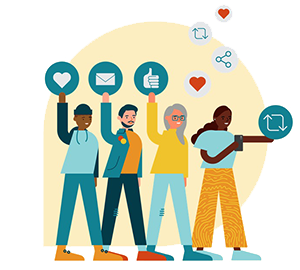
-
Section 3
How to Use Mass Email
-
Section 4
How to Use Mobile Alerts
-
Section 5
- Social Media
-
Contact Us
Get help, give feedback, or share resources
Social Media Strategy
Social media includes all digital (via computer, desktop, phone, tablet) platforms where people create communities using public posts, videos, personal messages, blogs and shared information. Some of the most popular social media platforms are Facebook, Twitter, and Instagram.
These days, social media is essential to engagement — both to tell the stories of your 100% clean energy work and to build relationships with your supporters. Social media has moved us from traditional one-way modes of communication from the past to an instant, interactive mode of conversation for the future. And social media helps amplify our advocacy efforts by reaching more people, in more places, faster than ever before.
In order to use social media effectively, it’s important to have a strategy. Take the time to create a clear plan of who your audience is, which social platforms are most suited to that audience, and what results you hope to gain from your efforts.

General Best Practices for Using Social Media
-
Social media channels are all about having a conversation. It's about talking back and forth with people who care about the same things as you. Make sure to use it that way. Don’t just push out information without participating in conversation. The golden rule online is, “Post unto others as you would have them post unto you.”
-
Understand the sensitivities of your audience. You’re building a long-term online relationship with each person you converse with online. As you post, reply, like, comment, etc., you will soon learn more about what your audience likes to see and discuss, as well as what they definitely do not want to see or chat about. Use this knowledge to better understand how you can introduce different topics to the conversation.
-
Every channel is different. Understand which one(s) are right for you and how to use it (or them). There are many social media channels, and definitely a few that are bigger than others in terms of user base. The best way to decide which to use is to understand what sites or apps the people you want to talk with are using. After you’ve figured out those outlets, make sure to understand what it’s like to be a user on those outlets! And don’t post the same content on all platforms — each has its own preferences, audience and purpose.
How-To
Social Media Strategy 101
Choose the right social media platform, follow the “3 S” Rule, try out the 3-step journey to diversifying your posts, learn some tips and tricks for Facebook and Twitter, and more!
How to Use Twitter
These days, Twitter is often where news is broken, links are shared, and memes are born.
While you are limited to 280 characters per tweet, you are more easily able to influence decision makers (remember to tag them!), share news articles, and create an engaging dialogue with influential users on Twitter.
Twitter Best Practices
-
Use visual storytelling. Tweeting high-quality photos and infographics has a ripple effect. People are more likely to click on the tweets before and after great photos or graphics.
-
Shorter is better. While you have up to 280 characters to get your message across, you should try to write shorter tweets. This makes it easier for someone to retweet you and add comments. (For a quick tool for character counting, visit www.lettercount.com.)
-
Share engaging content. Quotes, statistics, images, and links make for good tweets.
-
Use hashtags to join a conversation (see more about hashtags below).
-
Respond to @s (times when people use your name in a tweet), check your DM (direct message) inbox and RESPOND when people @ or DM you.
-
Post regularly. We recommend tweeting and/or retweeting at least once a day and up to 10 times a day.
-
Don’t be afraid to use shorthand that your community will understand , such as abbreviations, acronyms, and emoji.
-
Join the community. Follow local journalists, elected officials, other influencers, and your campaign’s strategic targets, and consider including their Twitter handles in your tweets announcing news. Retweet relevant content to diversify your history of tweets to a mixture of original content and shared content.
-
Use “@s” for key decision maker targets in your tweets! This means you’re sending tweets directly to the target, but all of your followers can see it. (Tip: add a “.” (period) before starting a tweet with an @NAME if you want all your followers to see it, not just the person you’re responding to.)
See a sample Tweet from Helena, Montana:
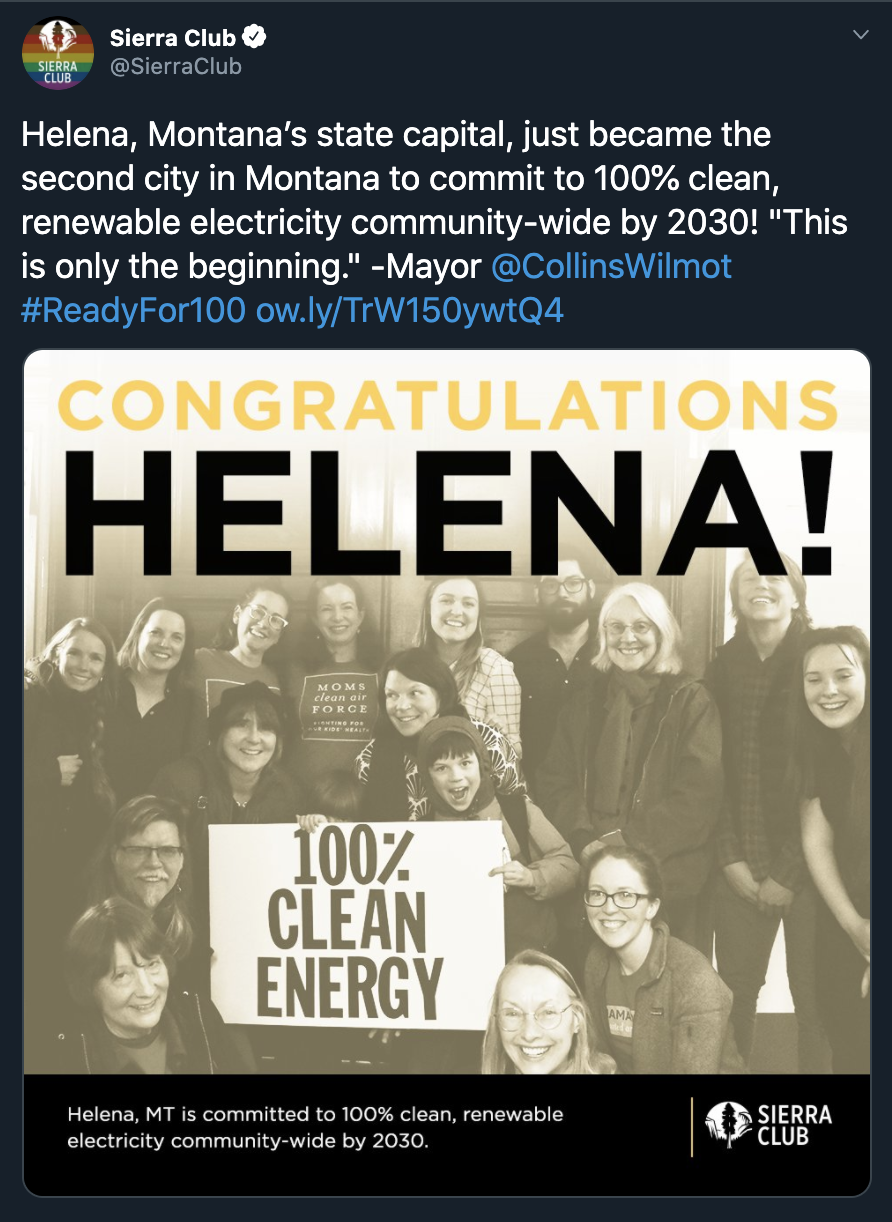
How to Use Instagram
Instagram is all about photos. It’s a great channel for eye-catching visual content. Share great photos of places that deserve to be protected, people-powered actions, and groups of folks in your community working to reach 100% clean energy for all.
Instagram Best Practices
-
Download the app! Although you can access Instagram on an internet browser, Instagram is mobile application-based, so you will need it installed on your smartphone to get the full experience.
-
Use hashtags. Instagram loves hashtags! Similar to other social media platforms, hashtags insert your images into a larger pool of images that are easily searchable. Use relevant hashtags, but don’t overdo it. Find more on hashtags below.
-
Keep it scannable. Avoid using too much text in images. Graphics can be great for sharing information, but don’t overload with text.
-
It’s OK (even good!) to cross-post. Share your Instagram pictures onto Facebook to engage more people. The Instagram app will give you this option when you post. Ideally, do not post the image to Twitter. You can use the same image, but go into Twitter to create a new post for it.
See a sample Instagram post from Chicago, Illinois:
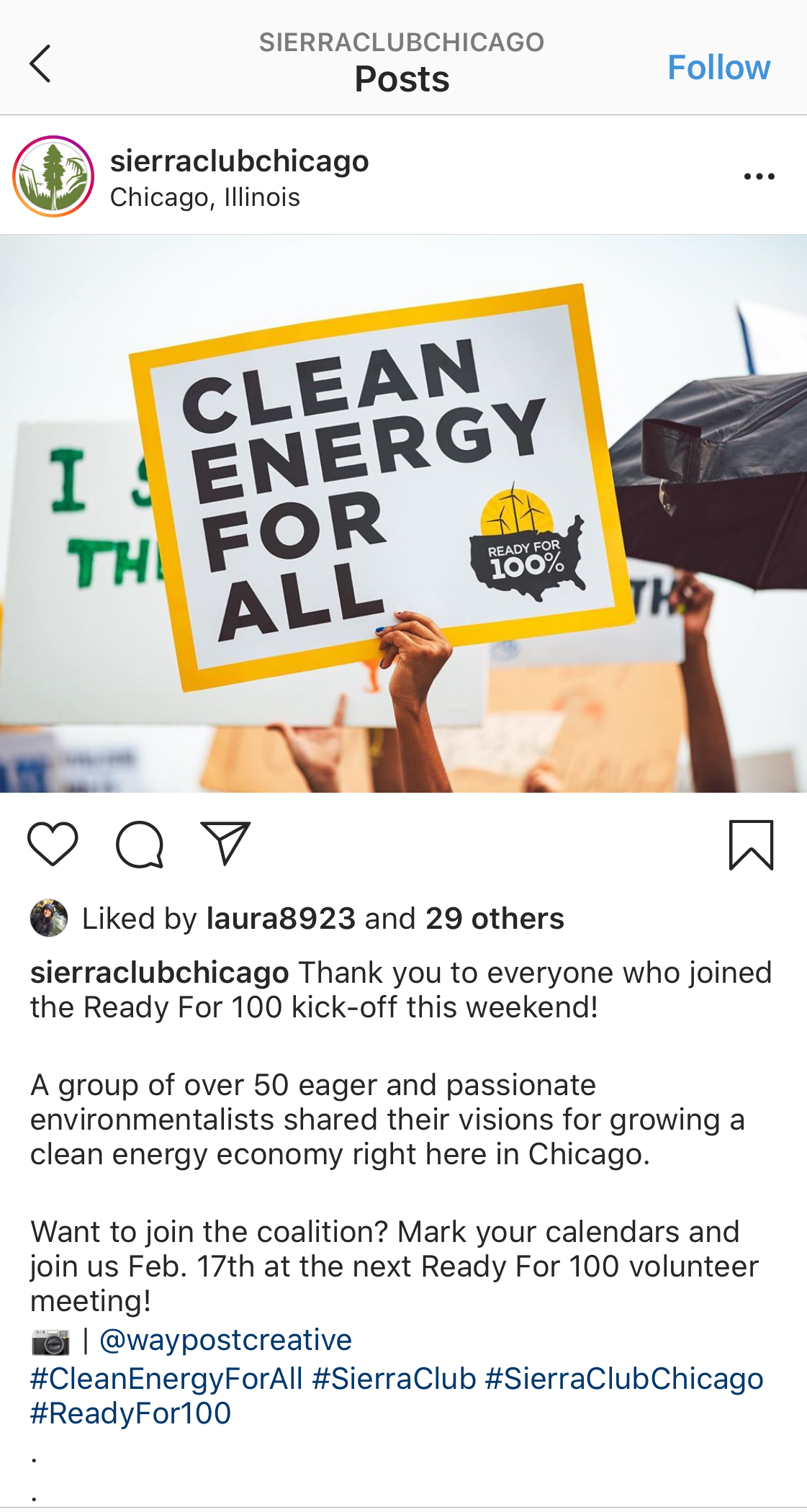
How to Use Facebook
Facebook is the best place to organize online! Not only is it the largest social network in the world, but Facebook allows you to do so many things. From messaging people directly to recruiting for an event or creating a group — it’s the easiest and most effective social media platform to organize on. Managing a Facebook page with fresh content and engaging with followers will help expand your campaign brand, increase connections and dialogue, and motivate supporters to take action.
Facebook Best Practices
-
Keep your copy short. Facebook copy can be longer than Twitter or Instagram, but still aim to say what you need to say in two or three sentences followed by a link, video, or photo. Ideally, your blurb should be less than 400 characters text (sweet spot is 150-200).
-
Use visual storytelling. People on social media love pictures and graphics. Post a single great photo on your timeline, upload photo albums of local events, and use photos to promote events. Share others’ pictures. “A picture is worth a thousand ‘likes.’”
-
Diversify your content. Post photos, graphics, news stories, blog posts, events, announcements, video, polls, etc., but remember, posts with images or videos typically perform the best.
-
Post consistently but don’t overdo it. Keep your content fresh, but don’t bog down your followers with information overload. Twice a day should be your maximum.
-
Engage your followers. Ask and answer questions, like favorable comments, and tag peoples' names when responding. Do not delete critical or antagonistic comments unless they harass or include profanity or spam. Follow campaigns, Sierra Club chapters, and other nonprofits to get ideas for content and engage in online conversation with them.
See a sample Facebook post from Utah:
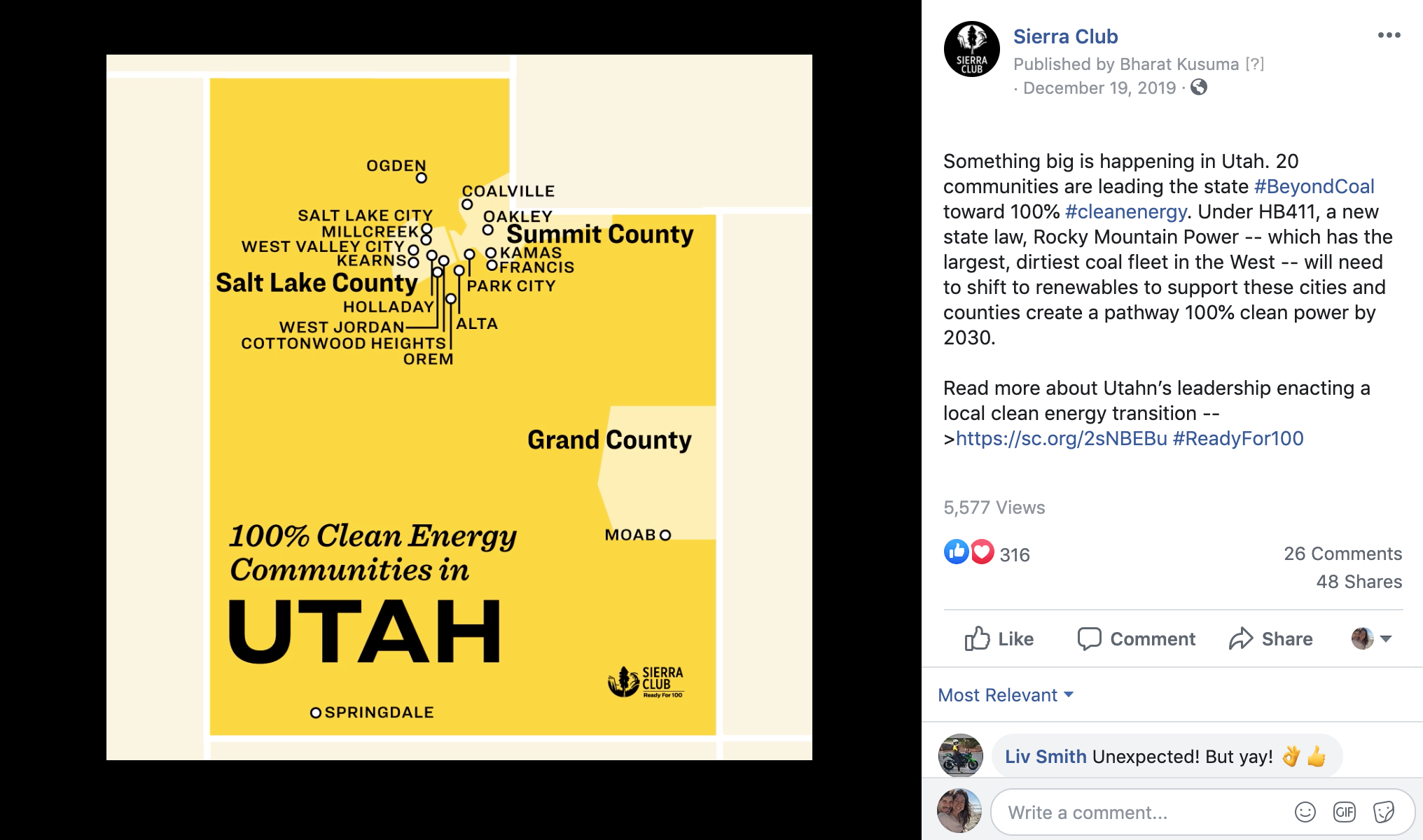
See a sample Facebook post from Keene, NH:
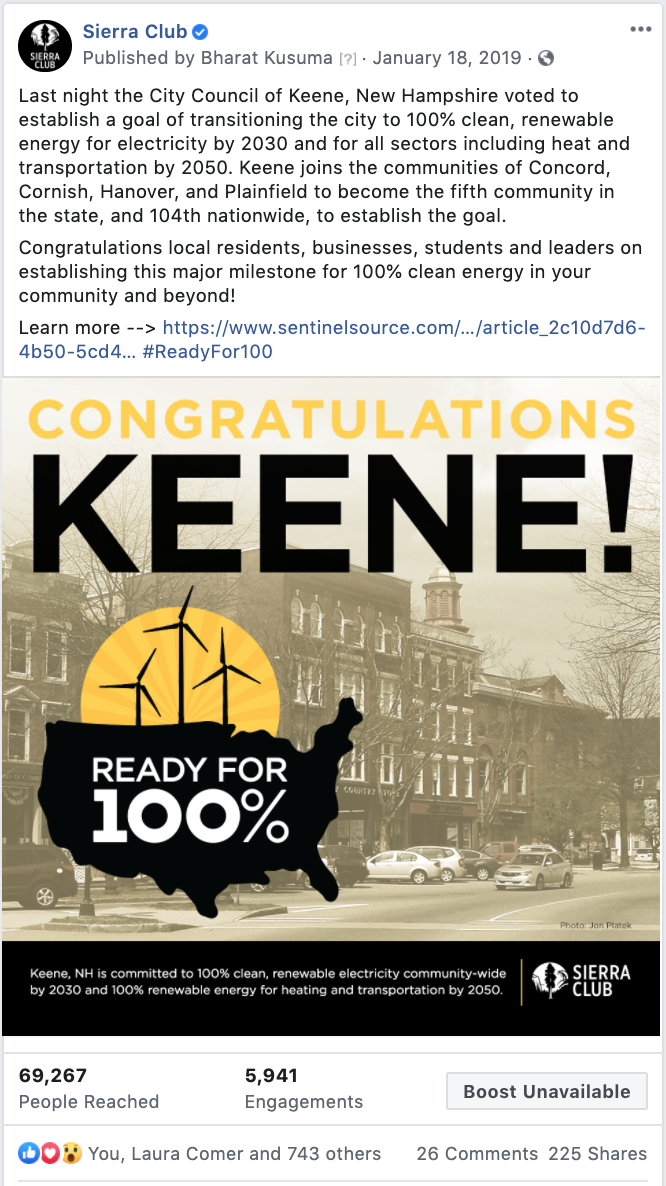
Hashtags & Handles
Tag (almost) everything!
By using hashtags (#) and mentions (@) strategically in social posts, we can reach larger audiences with our content, build relationships, and engage in direct relationships with other accounts (e.g. city leaders and stakeholders).
Hashtags, denoted by the # symbol, are used to mark clickable keywords or topics in a message. For example, if someone clicks on a hashtag for #CleanEnergyForAll, it will open up a search stream that shows all posts/tweets related to the topic.
-
Suggested Hashtags: #CleanEnergyForAll, #CleanEnergy, and #ActOnClimate
-
Others to use: #CleanEnergy, #ActOnClimate
Mentions, denoted by the @ symbol, allow you to tag an organization or individual’s account to let them know you’re talking about them.
-
Our Handle: @SierraClub
Try to answer these questions before moving on.
False. Shorter is usually sweet on Twitter and Facebook. Even though the platforms allow for long posts, try to keep things brief to encourage users to read and share.
False. While Instagram is the platform that’s only for photos, both Facebook and Twitter will get better responses if your posts include photos. The same photo can be used on all your platforms if you write the right type of post for each.
False. You only need to use the platforms that most effectively reach your audience. You should have done the research already to know where your supporters and targets are online. Communicate with them on the platforms they use most, and prioritize the platforms your team has the resources to use well.